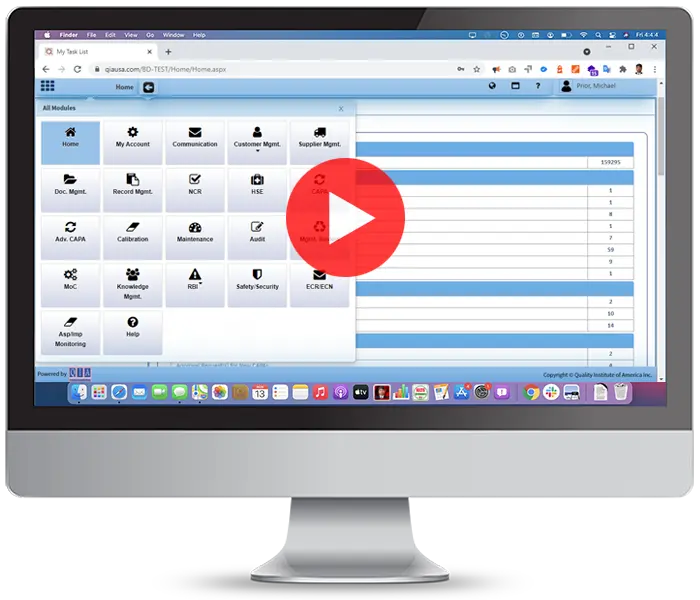Risk Management Software System
ISO standard based QMS QISS Offers Risk Management Software System for your company.
QISS gives you a complete view of your enterprise risk landscape. It includes all product lines, business units, procedures, quality management, document control, etc. The risk management software tracking and analysis features let you quickly identify and mitigate long-term system, process, and product risks.
This writing will discuss a Risk Management Software System of an ISO (International Organization for Standardization) standard-based quality management software QISS.
What is the QISS Risk Management System?
The QISS, Risk Management System, is designed to allow the user to perform the three steps of management:
a) Risk Assessment
b) Cause Analysis
c) Risk Prevention
The RBI or Risk-Based Improvement suite of modules contains the tools necessary to perform the above tasks and allows an organization to determine risk and its risk exposure.
The first module is risk assessment, where a user can initiate a risk assessment on an event or occurrence. The module allows the user to title and describe the risk situation and assign the risk assessment to a responsible person. Upon assignment, the responsible person will assign the consequence of the risk issue and determine the consequence detail by filling out the RPN( Risk Priority Number) formula. Formula contents and measurement details are determined during the setup phase of the module. The risk priority number is measured and determined by multiplying the likelihood of an event by the consequence of the said event. If the number is low, most organizations will deem the risk acceptable and move on. If the number is medium or higher, organizations will move forward with further inspections involving root cause analysis and prevention activities – based upon the RPN number. After further risk activities have been completed, the RPN should be lowered into an acceptable range for business continuation.
As described above, the second module is the Root Cause Analysis module. Here, a user can initiate a root cause action. QISS provides the option of a five why methodology format that aids the user in root cause determination. The results are stored in QISS and available for further use through the module’s search option.
The final module available in RBI is the prevention module. After assessing a risk event is completed, and a root cause has been determined, QISS has the prevention module that allows a user to describe and document a risk issue and corresponding root cause determination. The next steps are identical to corrective action in that the organization will develop a plan by assigning responsible persons to do so, initiate the plan in an agreed-upon manner, and, finally, to evaluate the effectiveness of the risk prevention plan as implemented.
Benefits and Features of QISS Risk Management System
Risk Assessment Module FEATURES/BENEFITS:
-
Ability to initiate internal, supplier, or customer risks
-
Charts & Reports
-
Advanced search feature
-
Ability to initiate local prevention for a particular risk that has already been assessed
-
Ability to manage “Risk Management” using FMEA or ERM method
-
Ability to configure RPN matrix or Risk score
-
Ability to record revised RPN with a contingency plan
-
Ability to add custom fields
Root Cause Module FEATURES/BENEFITS:
-
Initiates RCA
-
Assign Responsibility for RCA
-
Built-in 5-Why Process is optional
-
Records the results
-
Prevent the recurrence or occurrence of discrepancies, failures, and deviations through dashboards that provide a real-time, at-a-glance assessment of the status of risk assessments & preventive actions.
-
Get complete visibility into your RCAs and their impact.
-
Record and track all RCAs through this centralized web-based database so you can trend information and identify areas of increased risk.
-
Ensure Compliance with common management standards.
-
Satisfy and exceed audit, nonconformance, and corrective and preventive action requirements of many common standards such as ISO 9001, ISO 14001, and ISO 45001.
Risk Prevention Module FEATURES/BENEFITS:
-
Initiate local prevention for a risk that has already been assessed
-
Add custom fields
-
Assign a responsible person for each Risk Prevention (RP)
-
Complete RP steps (Developing Solution, Implementing Solution, and verifying effectiveness)
-
Prevent the recurrence or occurrence of discrepancies, failures, and deviations through dashboards that provide a real-time, at-a-glance assessment of the status of risk assessments & preventive actions
-
Ensure Compliance with common management standards.
-
Cultivate a companywide culture of continuous improvement
-
Control approvers for each RP step.
-
Get complete visibility into your risk management actions and their impact
-
Record and track all risk assessments and risk preventive actions through this centralized web-based database so you can trend information and identify areas of increased risk.
-
Satisfy and exceed audit, nonconformance, and corrective and preventive action requirements of many common standards such as ISO 9001, ISO 14001, and OHSAS 18001.
-
Mitigate risk and avoid unnecessary costs
The history of the QISS Risk Management System
The QISS Risk Management System was developed in 2017, primarily as the tool for risk assessment as dictated by the new ISO 9001:2015 international standard.
ISO 900:2015 introduced risk or risk-based thinking into the required components of the new standard. This type of analysis had not been previously required or delineated and has led to dramatic changes in the QMS of all organizations, large and small.
The risk module is designed with all the tools necessary to undertake a risk assessment, analysis, and evaluation as required by ISO 9001:2015. While the risk module is one of the newest in the QISS suite, it has developed into a cornerstone module for organizations to identify and assess risk in production, inspection, and supplier relationships.

